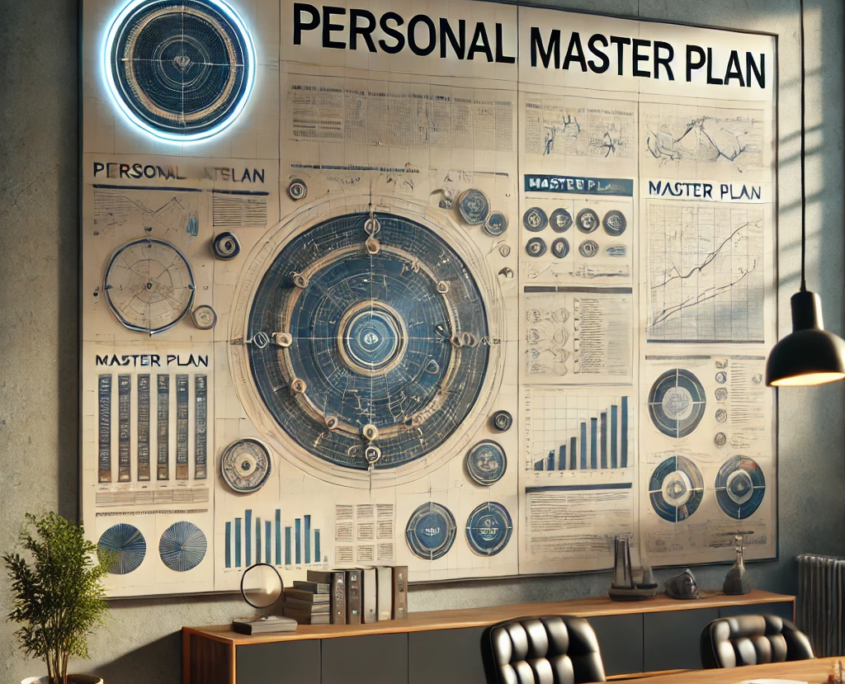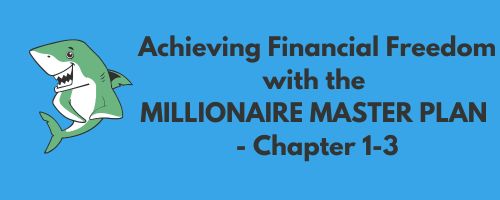Achieving Financial Freedom with the Millionaire Master Plan – Chapter 1-3
Just this morning I sat down (again) and read my book “Millionaire Master Plan”. Since November of last year I am constantly reading about 10 to 20 pages per day, which is some kind of a success for me. But only reading will not make me move on.
Now it is a pretty sunny sunday and I am sitting on my laptop, not really knowing how to take you on my personal financial journey. There are a lot of blogs on the internet and on social media, who are talking about their lifes. But nothing of them really fits to my situation, to be honest.
Over the last years I have been doing “something”, but I was not really able to work with grit. Andy Frisella has always been on my side, but I was not able to get things going.
Note: I wrote this blogpost my own and marked the parts, which are from Roger himself or with the help of AI. I do not want to create a blog or the whole journey based on AI – it is my journey and I will keep blogging about it. Regarding the podcast I used the help of AI. You can listen to the discussion here:
Table of Contents
Practical Roadmap “The Millionaire Master Plan”
Currently I am reading “The Millionaire Master Plan”. The author ist Roger Hamilton and this is how the AI describes him:
Meet Roger Hamilton, a renowned entrepreneur, author, and the founder of the Entrepreneurs Institute. Known for his innovative approach to personal and professional development, Hamilton has empowered countless individuals through his dynamic frameworks for success.
His expertise in understanding entrepreneurial profiles has culminated in the creation of the Wealth Dynamics system, which categorizes entrepreneurs to help them find the most natural path to success. His insights are practical, designed to be implemented in real-world scenarios.
In his book “The Millionaire Master Plan,” Roger Hamilton offers a compelling roadmap for financial growth and personal development. This book is not merely a collection of advice but a structured plan tailored to readers at different stages of their wealth journey.
For me, there are two incredibly important words in there: PRACTICAL and ROADMAP!

When you do not know, where to go, you need to work with a roadmap. Otherwise you will end up wherever life will push you and that might not necessarily be, where you want to end up.
And before I started I writing this blogpost I had the idea to put some work into the practical guidance of the book. To be honest this is what I really liked about the book so far: It is very practical. So why not work through instead of just reading it and then putting it aside?
Different Geniuses of the Wealth Dynamics System
Roger divides people into four different Geniuses. You can take the test on his website and find out, which Genius you are. In my case I am a Steel Genius, which stands for very analytical people overthinking things instead of starting them. Perfect match!
In Roger Hamilton’s Wealth Dynamics system, each of the eight profiles represents a specific type of entrepreneurial genius. The “Steel Genius” is one of these profiles, characterized by its focus on detail, reliability, and efficiency. Here’s a closer look at how Hamilton describes the Steel Genius:
- Detail-Oriented: The Steel Genius excels in managing and analyzing fine details. This ability is crucial in roles that require precision, such as data analysis, systems management, and operations.
- Systems and Processes: Individuals with a Steel profile thrive in environments where systems can be created or improved. They are excellent at setting up frameworks that increase efficiency and reduce waste.
- Introverted Nature: Typically, Steel Geniuses are more introverted, preferring to work behind the scenes rather than being at the forefront. They are the backbone of any enterprise, ensuring that everything runs smoothly and efficiently.
- Reliability: Dependability is a key trait of the Steel Genius. They are the individuals you can count on to deliver consistently and uphold the highest standards of quality.
- Risk Aversion: Unlike some of the other Wealth Dynamics profiles, Steel Geniuses tend to be risk-averse. They prefer making decisions based on solid data and proven methods rather than speculative ventures.
The Steel Genius is essential in any business, particularly in roles that require meticulous attention to detail and a systematic approach to tasks. Their ability to optimize and refine business processes makes them invaluable, especially in industries where precision and efficiency are paramount.
Want to know more about the Wealth Dynamics system? Check out this Youtube-Video:
What is the “Millionaire Master Plan”-Journey about?
Roger’s Wealth Dynamics System is pretty easy to understand. You usually start at the bottom and work your way through the Wealth Lighthouse, which Rogers describes in his book “Millionaire Master Plan”. To get to the top – which is pretty unlikely to happen – to take severals steps, in which you need to improve and work on your (mostly financial) knowledge and qualities.

Let’s shortly have a look at the different stages Roger describes in his book:
- Infrared (Victim) – At this stage, individuals are often struggling financially, possibly in debt, and feel like they have no control over their financial destiny.
- Red (Survivor) – Here, individuals have managed to stabilize their situation to avoid further debt but are living paycheck to paycheck without the ability to save or invest.
- Orange (Worker) – In this level, individuals work hard and manage to save money but are not yet leveraging their wealth to create further income.
- Yellow (Player) – Individuals at this level start to invest and leverage their wealth, often beginning to see significant returns on their investments.
- Green (Performer) – Here, the focus is on optimizing and growing investments and businesses with effective systems and teams.
- Blue (Conductor) – At this stage, individuals are leading larger teams and enterprises, focusing on significant business growth and investment opportunities.
- Indigo (Trustee) – This level involves overseeing substantial assets and often includes responsibilities to stakeholders and broader community interests.
- Violet (Composer) – Individuals at the top level have mastered their domain and are able to create opportunities and wealth seemingly at will, often contributing to large-scale projects and legacies.
I do not know, at which stage I am currently. I would say I am in debt and do not really have the control over my finances. This might sound a little harsh, but there are two reasons why I think like that:
#1 I gave up the control of my finances some time ago and I am not able to answer you any questions about them instantly
#2 I guess it is a refreshing idea for myself to start at the very bottom.
I will probably gain some steps over the next weeks and months, but setting it all up from the ground sounds like a very good idea for me. I am usually trying to skip the start, which led to where I am now. So I want to take it serious and work my own way through.
The Infrared Stage – Get the fuck out there
Reading the description of the Infrared Stage it does not sound comfortable there. It is more like really uncomfortable and a very nasty and dark place you do not want to be.
The moment you need more money each than you have sounds pretty broke. Am I currently broke? Let’s assume it, as I do not have further information about it.
Looking at my finances there is “something” invested, but there is also quite a lot of debt. And there is an always returning dream of my wife to buy a home. To be honest, I am absolutely not into buying a house. It feels like being fixed to a certain point in the world which reduces my freedom a big time.
Maybe I have to think of it differently – more like a home-base to come back to, if there is a need. Sounds like a business case? Probably yes and the business case will never be green and positive unlike we “change” the facts like we want to.
Nevertheless, to buy a home a get a good rating at the bank, you need to be “debt-free” and additionally have a financial amount to invest.
I checked the internet a bit about it. Here in Germany the sources say, that you must have a least 15% of the price as settlement costs. Additionally to receive a good interest rate for financing the house with a bank you should save at least 20% of the price.
Let’s sum it up: Save 35% of the price before buying a house – in my case!
But currently I am at the Infrared Stage and need to get out of it. Therefore Roger describes really practical plans for each Genius in his book.
The Three Steps Out of Infrared
Roger offers three simple steps for each Genius in his book. I just want to take a look at those three steps for my Steel Genius. The goal is to escape that Level as fast as possible for me. This will probably happen fast, but I need to do the work. Therefore let’s dive into the three steps.
#1 Step: Measure Your Money
You cannot manage what you cannot see. And therefore it is essential to know your numbers. Here of course my numbers are meant. I need to know what comes in each month, what my expenses are, where my income flows and why the heck at the end of the month there is no money left.
In that Infrared stage one of the first steps is to get a job and earn an income. That is already the case for me. Currently I have been working with a company for more than 10 years and also the mood changes from time to time, I feel pretty safe there.
Roger describes it the following way:
What’s coming in and going out? What is your personal flow? This first step goes beyond establishing discipline over how your money flows and extends to how your time and attention flow. For those of us who have fallen from a higher level of the lighthouse back into Infrared, this means letting go and any vestiges of that old level.

Hum, any ideas?
Of course it is necessary to get an overview of your finances. But there is also two other aspects in it, which are very important from my point of view: time and attention!
I really feel like finances take a lot of my time and attention. And it is not the case in evaluating investment cases, but thinking about how the bad finances influence my life.
Personally I like the idea here of an emergency fund. To get through rainy days, you need to save something. The moment your car breaks down or you lose your jobs, is the moment where money pops up on your screen with a huge red alert.
And I feel much more relaxed the next moment, when I know there is something in my emergency fund which covers my expenses for the next x months. So to feel like leaving the Infrared stage in my case there are several to dos until next week:
#1 Get a financial overview incl. tracking my expenses
#2 Introduce an emergency fund and define, which amount feels “ok” to leave Infrared
#3 Take care about my time & attention
#2 Step: Commit To Conduct
A probably very good quote here is: If nothing changes, nothing changes! 🙂
Old, but good. There will be no progress without changing my routines and habits. How I act today is the outcome of my decisions before. And they feel pretty bad looking at what I have today – to be honest.

Roger describes the point as follows for Steel Geniuses:
The code by which you live each day needs to change if your habits are going to change. The key to your conduct is a commitment to reliability and consistency.
I have the tendency to make this easier as they are. The moment I start writing a journal, is the moment I tend to quit it the next three days, as I cannot find a positive side for me. That might saves my time, but especially when working on my finances and myself, this is the road the failure.
Therefore this point is the most important for me: Doing, what needs to be done! Every day. Every single day.
I need to stop expecting a different outcome from no changes. That is a dumb idea to hope for and is definitely the wrong commitment towards my goals.
#3 Step: Do Your Duty
It sounds a little bit like the second point, but Roger has a different description here. He does not look and commitment, but more on the “duty”. Having a duty means in my case to cooperate with someone and to be accountable.
So, let’s see what Roger noted here:
Do not cut yourself off from those around you while you try to work things out.
Do find someone – anyone – to be accountable to: Hold yourself to a bigger cause with a dynamic leader or people person to work with to get your back into flow.
Cutting myself of anybody else means to not be accountable to anyone – as there is no one who knows about my plans. Therefore I created a new Instagram profile for my journey, where I will put my steps into the story and save them to the archive “Millionaire Master Plan”.
Feel free to be my accountability partner and make me yours.

Building the basic structure for the Millionaire Master Plan
So, that’s where I stand right now—getting the basics right, step by step. The first three chapters of The Millionaire Master Plan have given me a solid starting point, but reading alone won’t change anything.
I need to put the principles into action. Tracking my money, committing to small but consistent habits, and holding myself accountable are the first real steps to moving out of Infrared. No more skipping ahead, no more overthinking. Just doing the work. My to-do list for this week:
- Get a full financial overview, including tracking my expenses.
- Set up an emergency fund and define what “safe” looks like for me.
- Stay mindful of where my time and attention go.
- Build daily habits that reinforce consistency.
- Show up and document my progress—no excuses.
Let’s get to work. 🚀


Leave a Reply
Want to join the discussion?Feel free to contribute!